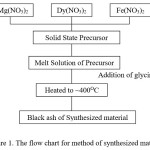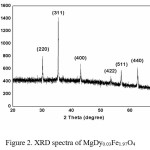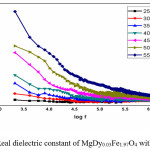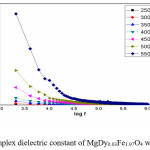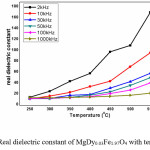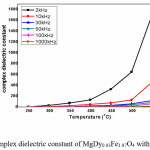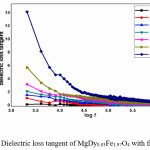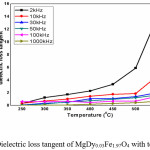Jeevan S. Ghodake
Materials Research Laboratory, Department of Physics, Padmabhushan Dr. Vasantraodada Patil Mahavidyalaya, Tasgaon, Dist: Sangli, 416 312, Maharashtra, India, Affiliated to Shivaji University, Kolhapur
Corresponding author email: jeevan.ghodake@rediffmail.com
DOI : http://dx.doi.org/10.13005/msri/150106
Article Publishing History
Article Received on : 15 December 17
Article Accepted on : 11 January 18
Article Published : 12 Jan 2018
Plagiarism Check: Yes
Article Metrics
ABSTRACT:
Dysprosium substituted Magnesium ferrite weresuccessfully prepared by chemical combustion method. The as synthesized powder was presintered in air at 6000C for 1hr and finally sintered at 9500C for 1hr. From X-ray powder diffraction pattern of MgDy0.03Fe1.97O4, confirmed formation of single phase cubic spinel structure. The value of crystallite size obtained from X-ray powder diffraction (311) peak , it is found to be 46.38nm.The frequency and temperature variation of dielectric parameters such as real dielectric constant (ε′), complex dielectric constant (ε") and dielectric loss tangent (tanδ) were determined using Hioki LCR - Q meter. The frequency variation of dielectric constant shows a normal dielectric behavior of spinel ferrites. The dielectric loss tangent with frequency shows similar behavior as dielectric constant. The dielectric constant and dielectric loss tangent increases with increase in temperature
KEYWORDS:
Combustion route; Dielectric constant; Ferrite; XRD
Copy the following to cite this article:
Ghodake J. S. Dielectric Behavior of Dysprosium Substituted Magnesium Ferrite. Mat.Sci.Res.India;15(1)
|
Introduction
Nanocrystalline ferrites have very good electric, dielectric and magnetic properties and number of applications from radio frequencies to microwave frequencies. The dielectric constant, dielectric loss, loss tangent and resistivity of ferrites are necessary to know for high frequency electrical applications.1 The properties of electrical insulating materials are depends upon preparation method, chemical composition and type of additives.2 Magnesium ferrite is a soft magnetic n – type semiconducting material, have high Curie temperature, high resistivity and environmental stability; hence it is most suitable for sensing applications.3 Magnesium ferrites are widely used as catalysts have many applications in adsorption sensors, electric and magnetic technologies.4,5
Rare earth element substituted into spinel type structure of ferrite, which can modify electrical as well as magnetic parameters of ferrites.6 Rare earth doped ferrite material have high resistivity and good electrical insulators. K. K. Bamzai et al.4 have investigated structural and magnetic parameters of dysprosium – magnesium ferrite. They have observed formation of secondary phase for substitution of small concentration of rare earth ion. N. Rezlescu et al.7 have studied substitution of small amount of rare earth ions instead of iron, produces modification of magnetic and electrical properties. N. Sivakumar et al.8 have studied electrical behavior of magnesium ferrite synthesized by ceramic route followed by mechanical milling. They have reported the anomalous behavior of real dielectric constant which is based on the presence of both n type and p type charge carriers. Hemaunt Kumar et al.9 have reported electrical parameters of dysprosium doped cobalt ferrite. They have showed that as frequency increases the value of electrical parameters decreases. Smitha Thankachan et al.6 have synthesized rare earth doped magnesium ferrite by sol-gel method. They have reported rare earth doped samples exhibit high conductivity than undoped magnesium ferrite.
The dielectric permittivity of ferrite material depends upon material synthesized process, calcination and sintering temperatures. The main aim of the present work to investigate the dielectric parameters of Dysprosium substituted Magnesium ferrite synthesized by combustion method.
Materials and Methods
Magnesium – Dysprosium ferrites having composition MgDy0.03Fe1.97O4 were preparedby combustion method. In this method, we have used oxidizing agents are metal nitrates and combustion agent is glycine10. The flow chart for method of synthesized material is as shown in figure 1. The as synthesized powder was presintered in air at 6000C for 1hr. Add binder such as polyvinyl alcohol in to presintered powder and it is uniaxially pressed at six tones per inch, to form pellet shaped material having thickness 1.5 centimeter and diameter 1 centimeter. Finally, prepared pellet shaped material and powder was sintered at 9500C for 1hr.
Pellet of sample MgDy0.03Fe1.97O4 were used for measurement of dielectric behavior by using Hioki’s LCR meter at different frequency and temperature. For measurement of dielectric parameter, silver conducting materials was coated on both surfaces of pellets. The dielectric parameter such as real dielectric constant, complex dielectric constant (dielectric loss) and loss tangent were studied with frequency for different temperature by using Hioki’s LCR meter. The dielectric constant (ε′) of the pellet shaped ferrite material was calculated by using the formula,9

Where, єo is permittivity of the free space, c is capacitance of pellet shaped ferrite material, d is thickness of the pellet, and A is area of the pellet.
The loss tangent or dissipation of the dielectric (tanδ) material was determined by the relation:
tan δ = 1/Q , where Q is the quality factor
The dielectric loss (ε′′) of the pellet shaped ferrite material is ε′′= ε′ tanδ
Results and Discussion
X-ray diffractograms of MgDy0.03Fe1.97O4 sintered at temperature 9500C is as shown in figure 2. The XRD pattern can be easily indexed to cubic spinel crystal of magnesium ferrite (JCPDS 73 – 1960). From XRD pattern it is identified that MgDy0.03Fe1.97O4 have cubic crystal structure. The lattice constant of ferrite material was calculated by using the formula, ; Where is the lattice constant; d is the interplaner spacing; h, k, and l are Miler indices of the crystal planes. The lattice parameter was observed from XRD data is 8.14Ao. The average crystallite size determined by Debye-Scherrer’s equation using FWHM of the (311) reflection and it is found to be 46.38nm.
Dielectric behavior of ferrites depends upon cation distribution on tetrahedral (A) sites and octahedral (B) sites in the spinel structure. Magnetism ferrites are good nanostructured electrical materials and its dielectric behavior was depends upon grain size and method of synthesis.8 Frequency variation curve of dielectric constant and dielectric loss of MgDy0.03Fe1.97O4 at various temperatures are represented in fig.3 and 4. It is observed that for lower frequencies the value of dielectric constant decreases rapidly while at higher frequency it becomes steady. This is normal behavior of MgDy0.03Fe1.97O4 ferrites and such type of behavior also discussed by several researchers in different ferrite system.9,11,12,13 The changes in dielectric constant at low frequencies can be discussed with the Maxwell – Wagner’s interfacial polarization effect14,15,16. The conduction process in ferrite materials can be explains with the hoping of charge carriers between pair of ions Fe3+ and Fe2+. The ferrite material has heterogeneous structure. It consists of two layers; in which large conducting layer of grains separated by thin layer of conducting grain boundaries1,16,17. When electrons come to the grain boundary due to hopping mechanism; such electrons crowded at the grain boundary and produces space charge polarization. But electrons moves reverse in their motion, as increase the frequency of field therefore corresponding probability of electron reaching to layer of grain boundary decreases, as a result decreases space charge Polarization. Hence dielectric constant of material decreases rapidly as frequency of field increases.
Figure 5 and 6 shows thermal variations of dielectric constant of MgDy0.03Fe1.97O4 sintered at temperature 9500C for different frequencies. In figure 5 and 6, it is seen that as temperature increases the value of dielectric constant increases for all frequencies. Also it is found that this temperature variation in dielectric constant is very large at low values of frequencies while for higher value of frequency the variation is very small. The observed values of temperature dependence dielectric data of MgDy0.03Fe1.97O4 at sintering temperature 9500C for 10 kHz, 100 kHz and 1000 kHz are summarized in Table 1. The dielectric permittivity of material is mainly depends upon dipolar, electronic, ionic and interfacial polarizations. Mainly dipolar and interfacial polarizations are temperature dependent. But as temperature increases the interfacial polarization increases while dipolar polarization decreases. Hence at low frequencies dielectric constant increases with increase in temperature which is depends upon interfacial polarization. But dielectric constant at higher frequencies depends upon electronic as well as ionic polarizations but its temperature dependent contributions are insignificant. Therefore for higher frequencies, constant and low value of dielectric constant is observed.1,18
Dielectric loss tangent represents dielectric absorption in a material. Figure 7 and 8 shows dielectric loss tangent with frequency and temperature. Dielectric loss tangent with frequency and temperature shows similar behavior as dielectric constant. The value of loss tangent depends upon structural homogeneity, iron content and stoichiometry19. The dielectric loss tangent at lower frequencies decreases rapidly with increase in frequency but for higher frequencies dielectric loss tangent decreases slowly. The variation of loss tangent with temperature of Dysprosium substituted Magnesium ferrite increases as temperature increases is as shown in figure 8. Similar results are reported for dysprosium doped cobalt ferrites,13 nickel – zinc ferrite and Gd doped nanocrystalline cobalt ferrite.20
Figure 1: The flow chart for method of synthesized material
Figure 2: XRD spectra of MgDy0.03Fe1.97O4
Figure 3: Real dielectric constant of MgDy0.03Fe1.97O4 with frequency
Figure 4: Complex dielectric constant of MgDy0.03Fe1.97O4 with frequency
Figure 5: Real dielectric constant of MgDy0.03Fe1.97O4 with temperature
Figure 6: Complex dielectric constant of MgDy0.03Fe1.97O4 with temperature
Figure 7: Variation of dielectric loss tangent (tand) with temperature at different frequencies.
Figure 8: Dielectric loss tangent of MgDy0.03Fe1.97O4 with temperature
Table 1: Temperature dependence dielectric data of MgDy0.03Fe1.97O4
|
Temp.
oC
|
10kHz
|
100kHz
|
1000kHz
|
|
ε’
|
ε”
|
tanδ
|
ε’
|
ε”
|
tanδ
|
ε’
|
ε”
|
tanδ
|
|
300
|
17.23
|
11.80
|
0.68
|
13.28
|
7.55
|
0.57
|
13.97
|
0.69
|
0.05
|
|
350
|
23.96
|
23.97
|
1.00
|
14.16
|
9.63
|
0.68
|
14.62
|
1.19
|
0.08
|
|
400
|
34.66
|
49.76
|
1.43
|
16.18
|
7.24
|
0.45
|
15.25
|
2.78
|
0.18
|
|
450
|
44.35
|
77.71
|
1.75
|
21.79
|
22.6
|
0.67
|
16.77
|
4.95
|
0.29
|
|
500
|
71.09
|
131.4
|
1.85
|
28.19
|
19.1
|
0.68
|
18.62
|
8.20
|
0.44
|
|
550
|
96.81
|
463.5
|
4.76
|
41.19
|
60.8
|
1.47
|
22.67
|
15.21
|
0.67
|
Conclusions
Dysprosium substituted Magnesium ferrite weresuccessfully prepared by combustion route. From X-ray spectrograph of MgDy0.03Fe1.97O4, confirmed cubic single phase structure of synthesized material. Crystallite size obtained from X-ray powder diffraction (311) peak and it is found to be 46.38nm. The dielectric constant with frequency of MgDy0.03Fe1.97O4, shows a normal dielectric nature.Dielectric constant at low frequencies changes considerably with increasing temperature which is discussed with the Maxwell-Wagners type of interfacial polarization. Dielectric constant and loss tangent increases as temperature increase. The loss tangent with temperature and frequency shows similar behavior as dielectric constant.
Acknowledgment
The author would like to thank the faculty of Department of Physics of Padmabhushan Dr. Vasantraodada Patil Mahavidyalaya, Tasgaon,
Conflict of interest
The author(s) declare(s) that there is no conflict of interests regarding the publication of this article
Funding Source
There has been no financial support given by any funding agency for this work.
References
- Santosh s. J., Sagar E. S., Toksha B. G., Shengule D. R., Jadhav K. M. Journal of optoelectronics and Advanced Materials. 2008;10:2644-2648.
- Mangalaraja R. V., Ananthakumar S.,Manohar P.,Gnanam F. D. Journal of Magnetism and Magnetic Materials. 2002;253:56-64.
CrossRef
- Deraz M. M and Omar H. Abd-Elkader. Int.J. Electrochem. Sci. 2013;8:8632–8644.
- Bamzai K. K., Kour G.,Kaur B., Arora M., Arora M., Pant R. P. Journal of Magnetism and Magnetic Materials. 2013;345:255-260.
CrossRef
- Pradhan S. K.,Bid S., Gateshki M., Petkov V. Materials chemistry and Physics. 2005;93:224-230.
CrossRef
- Thankachan S., Binu P. J., Xavier S and Mohammad E. M. Phys. Scr. 2013;87:7.
CrossRef
- Rezlescu N., Rezlescu E., Panicu C and Craus M. L. Journal of Physics Condensed Matter. 1994;6:5707-5716.
CrossRef
- N. Sivakumar A. N., Greneche J. M., Murugaraj R., Lee Y. S. Journal of Alloys and Compounds. 2010;504:395-402.
CrossRef
- Kumar H.,Pal J. S., Srivastava R. C., Negi P., Agrawak H. M and Asokan K. Journal of Nanoscience. 2014;2014:Article ID 862415:10.
- Kambale R. C.,Shaikh P. A., Bhosale C. H., Rajpure K. Y and Kolekar Y. D. Smart Mater. Struct. 2009;18:115028.
CrossRef
- Binu P. J., Smitha T. S and Mohammed E. M. Journal of Alloys Compounds. 2013;578:314-319.
- Ateia E., Ahmed M. A andGhouniem R. M. International Journal of Modern Physics B. 2015;29:13.
CrossRef
- Xavier S. Xavierian Research Journal. 2014;2(2):59-66.
- Sutka A., Gross K. A., Mezinskis G., Bebris G and Knite M. Phys. Scr. 2011;83(6):025601:
- Heywang W. J. Am. Ceram. Soc. 1964;47:484.
CrossRef
- Koops C. G., Phys Rev. 1951;83:121.
CrossRef
- Wagner K. W. Ann. Physics. 1913;40:817–855.
CrossRef
- Hench L. L., West J. K. Principles of Electronics Ceramics, Wiley. New York. 1990;189.
- Nasir S and Anis-ur-Rehman M. Phys. Scr. 2011;84(7):025603.
- Pervaiz E and Gul I. H. Journal of Physics: Conference Series. 2013;439:012015.
CrossRef
Views: 933
 This work is licensed under a Creative Commons Attribution 4.0 International License.
This work is licensed under a Creative Commons Attribution 4.0 International License.
 Material Science Research India An International Peer Reviewed Research Journal
Material Science Research India An International Peer Reviewed Research Journal



